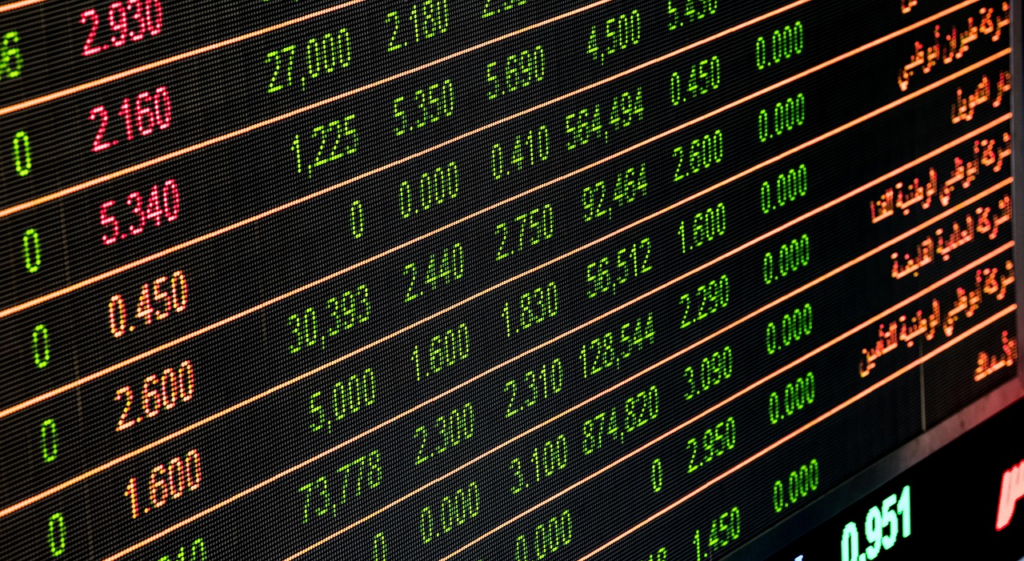Advertisement
You may have heard of the stock market, but perhaps you don't have a complete understanding of what it is and how it works. In this article, we'll explore in detail the concept of the stock market, how it works, and how to interpret charts to understand the stock market.
What is a stock exchange?
A stock exchange is an organized and regulated market where various types of financial assets are traded, such as company shares, debt securities (such as government bonds and debentures), commodities (such as gold, oil and grains) and derivatives (such as options and futures contracts). These trades take place between investors and financial institutions authorized to operate on the exchange.
Advertisement
The main objective of a stock exchange is to provide a safe and transparent environment for buying and selling assets, guaranteeing market efficiency and liquidity of the assets traded. This means that investors can carry out transactions quickly and at fair prices, without the need to find individual buyers or sellers.
In addition, stock exchanges play a fundamental role in the economy, providing capital for companies to finance their projects and expansions. When a company decides to go public and sell shares on the stock exchange, it is accessing the capital market to obtain funds that will be used for investments, research and development, or even to pay off debts.
Advertisement

Stock exchanges also contribute to the price formation of financial assets, reflecting investors' expectations and perceptions of the future performance of companies and the economy as a whole. This means that the price movements of shares and other assets on the stock exchange are influenced by a number of factors, such as companies' financial results, economic indicators, market news and geopolitical events.
How does a stock exchange work?
The operation of a stock exchange is based on a series of processes and systems that facilitate trading between buyers and sellers of financial assets. Here are the main elements that make up the operation of a stock exchange:
1. Trading Platform
Trading on the Stock Exchange takes place on an electronic platform, which allows investors and brokers to send orders to buy and sell assets. This platform is operated by the Exchange itself, and each transaction is recorded in real time.
- Order Execution: The trading platform allows investors to send orders to buy and sell financial assets. These orders can be of different types, such as market orders (executed immediately at the current market price), limit orders (executed only when the price reaches a specific value) and stop orders (activated when the price reaches a certain level).
- Access to Market Data: The platform provides real-time access to market data, including price quotes, trading volumes, price charts and order book information. This data is essential for investors to make informed trading decisions.
- Portfolio Monitoring: Many trading platforms allow investors to monitor their investment portfolios, tracking the performance of their assets, the available balance in their accounts and their transaction history.
- Technical Analysis Tools: Some platforms offer integrated technical analysis tools, such as technical indicators, advanced charts and pattern scanners, which help investors identify trends, patterns and trading opportunities.
- Fast and Secure Execution: The trading platform must guarantee fast and secure execution of orders, minimizing latency time and reducing the risk of technical failures that could harm investors' trades.
2. Sales Order
Investors who want to buy or sell financial assets on the stock exchange send buy and sell orders through their brokers.
- Buy Order: A buy order is an instruction given by an investor to purchase a particular financial asset at a specific price or at the best price available on the market. The investor specifies the desired asset, the quantity to be purchased and the maximum price they are willing to pay. The buy order is then sent to the stock exchange and included in the order book, where it waits until a corresponding sell order is found.
- Sell Order: On the other hand, a sell order is an instruction given by an investor to sell a financial asset they already own at a specific price or at the best price available on the market. The investor specifies the asset to be sold, the quantity to be traded and the minimum price at which they are willing to sell. The sell order is then sent to the stock exchange and included in the order book, where it waits until a corresponding buy order is found.
3. Gift book
Buy and sell orders are recorded in the order book, which is a system that organizes orders by price and quantity. The order book shows investors the best buy and sell offers available on the market at any given time, allowing them to make trading decisions based on this information.
- Liquidity assessment: The order book allows investors to assess the liquidity of the market, i.e. the ease with which they can buy or sell the asset without significantly affecting its price.
- Identifying Support and Resistance Levels: Price levels with a large number of buy orders can act as support levels, while price levels with a large number of sell orders can act as resistance levels.
- Market Sentiment Analysis: The behavior of the order book can provide insights into market sentiment, indicating whether market participants are optimistic (more buy orders) or pessimistic (more sell orders) about the asset.
4. Price formation
Price formation is one of the most fundamental aspects of how a stock exchange works. It refers to the process by which the prices of financial assets are determined based on the interaction between supply and demand in the market. Understanding how price formation takes place is essential for investors to understand market movements and make informed choices about their trades.
- Supply and Demand: Supply represents the quantity of an asset that sellers are willing to sell at a given price, while demand represents the quantity that buyers are willing to buy at that price. When demand exceeds supply, prices tend to rise, and vice versa.
- Investor expectations: Investors' expectations regarding the future performance of an asset also influence price formation. For example, if investors believe that a company will have a positive financial performance in the future, they will be more willing to pay a higher price for its shares in the present.
- External factors: Economic, political and geopolitical events, as well as market news and information, can have an impact on the price formation of financial assets. For example, an announcement of a company's positive financial results can lead to an increase in its share price.
- Government intervention: The intervention of government authorities, such as central banks and regulators, can also influence price formation, through monetary policies, regulations and economic stimulus measures.
5. Settlement and Custody
Once an asset has been traded on the stock exchange, the transaction must be settled, i.e. the buyer must pay for the asset and the seller must deliver it. This process is intermediated by financial institutions responsible for the custody of the assets and the transfer of funds between the parties involved in the trade.
6. Regulation and Supervision
Stock exchanges are regulated and supervised by government bodies, which establish rules and standards to ensure the transparency, integrity and security of the market. These rules range from the disclosure of information by listed companies to the prevention of abusive and fraudulent practices.
Interpreting Stock Market Charts
Charts are essential tools for monitoring and analyzing the performance of assets traded on the stock exchange. There are different types of charts, but the most common are line charts, bar charts and candlestick charts.
Line Chart
This type of chart shows the movement of an asset's price over time using a simple line. It is useful for identifying upward, downward or stable price trends.
- Trends: The line chart is useful for identifying upward, downward or stable price trends. An ascending line indicates an uptrend, while a descending line indicates a downtrend. A horizontal line suggests that the asset's price is stable.
- Support and Resistance: Support and resistance levels can be identified on the line chart. A support level is a point where there is a sufficient concentration of buyers to prevent the price from falling further, while a resistance level is a point where there is a sufficient concentration of sellers to prevent the price from rising further.
- Chart Patterns: Although the line chart is less detailed than other types of charts, it is still possible to identify basic chart patterns, such as the "Head and Shoulders" reversal pattern or the "Triangle" continuation pattern.
Bar Chart
Bar charts provide information on the opening, closing, maximum and minimum price of an asset over a given period of time. Each bar represents a specific time interval and provides a more detailed view of price behavior.
- Bar Body: The widest part of the bar, known as the body, represents the difference between the opening price and the closing price of the asset during the selected period. If the closing price is higher than the opening price, the body of the bar is usually colored green or white, indicating an uptrend. If the closing price is lower than the opening price, the body of the bar is usually colored red or black, indicating a downtrend.
- Upper and Lower Lines: The lines extending upwards and downwards from the body of the bar represent the maximum and minimum prices reached by the asset during the selected period, respectively. These lines provide additional information on the volatility and amplitude of price movements.
- Chart Patterns: Bar charts are often used to identify chart patterns, such as reversal patterns (e.g. "double top" or "double bottom") and continuation patterns (e.g. "flag" or "pennant").
Candlestick Chart
Candlestick charts are similar to bar charts, but provide a more intuitive visual representation of price movements. Each candle has a body and two shadows, representing the range between the opening and closing price, and the high and low prices respectively.
- Candlestick body: If the closing price is higher than the opening price, the candlestick body is usually colored green or white, indicating an uptrend. If the closing price is lower than the opening price, the body of the candlestick is usually colored red or black, indicating a downtrend.
- Shadows (Wicks): The shadows (or wicks) represent the maximum and minimum prices reached by the asset during the selected period. The upper shadow indicates the maximum price reached during the period, while the lower shadow indicates the minimum price reached. The longer the shadows, the greater the volatility during the period.
- Candlestick Patterns: Candlesticks form a variety of patterns that can provide insights into market psychology and possible trend reversal or continuation points. Some of the most common candlestick patterns include the "hammer", the "bullish engulfing" and the "doji".

A dynamic and complex market
The stock market is a dynamic and complex market where investors trade a variety of financial assets. Understanding how it works and using tools such as charts can help investors make more informed decisions and maximize their returns.
If you are interested in investing in the stock market, it is important to study and seek knowledge about the different aspects of the financial market. With the right education and a disciplined approach, it is possible to achieve success as a stock market investor.
See also: Rent Adjustment: How much is allowed by law?
March 31, 2024

She has a degree in Languages - Portuguese/English, and is the creator of the Escritora de Sucesso website. As a writer, she seeks to expand everyone's knowledge with relevant information on various subjects. At SoMuchToSayToday, she brings news and content ranging from entertainment to the country's economic situation.



